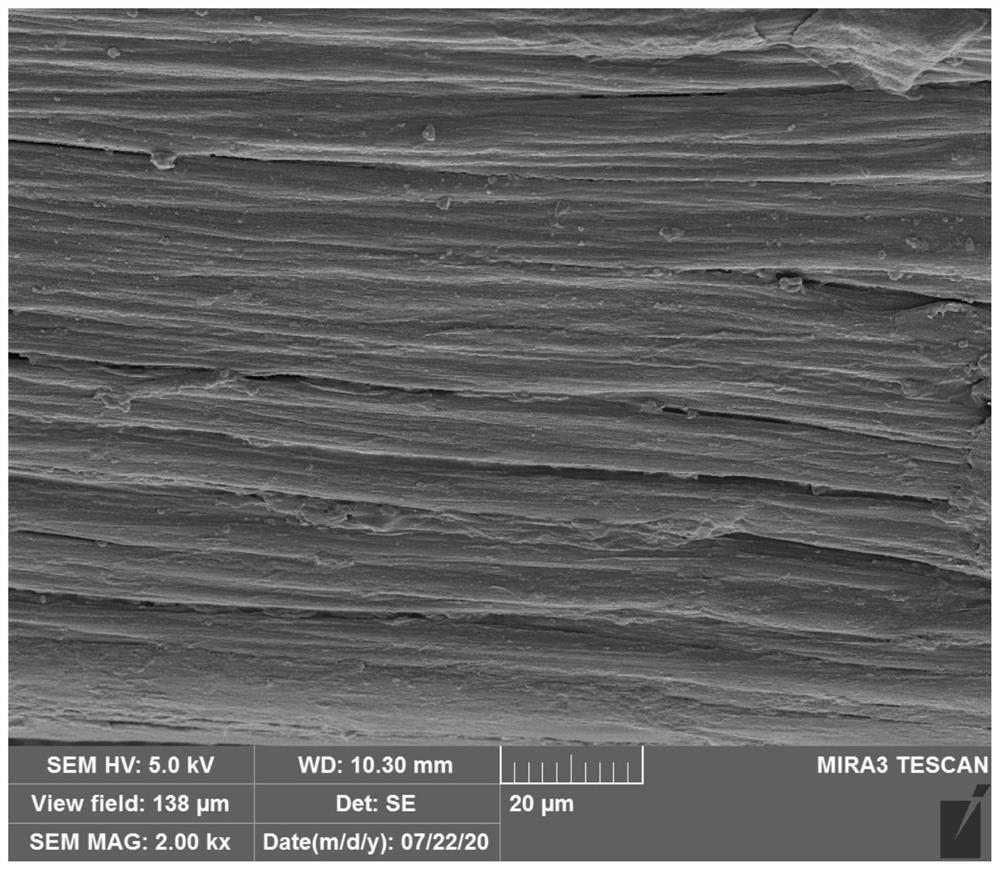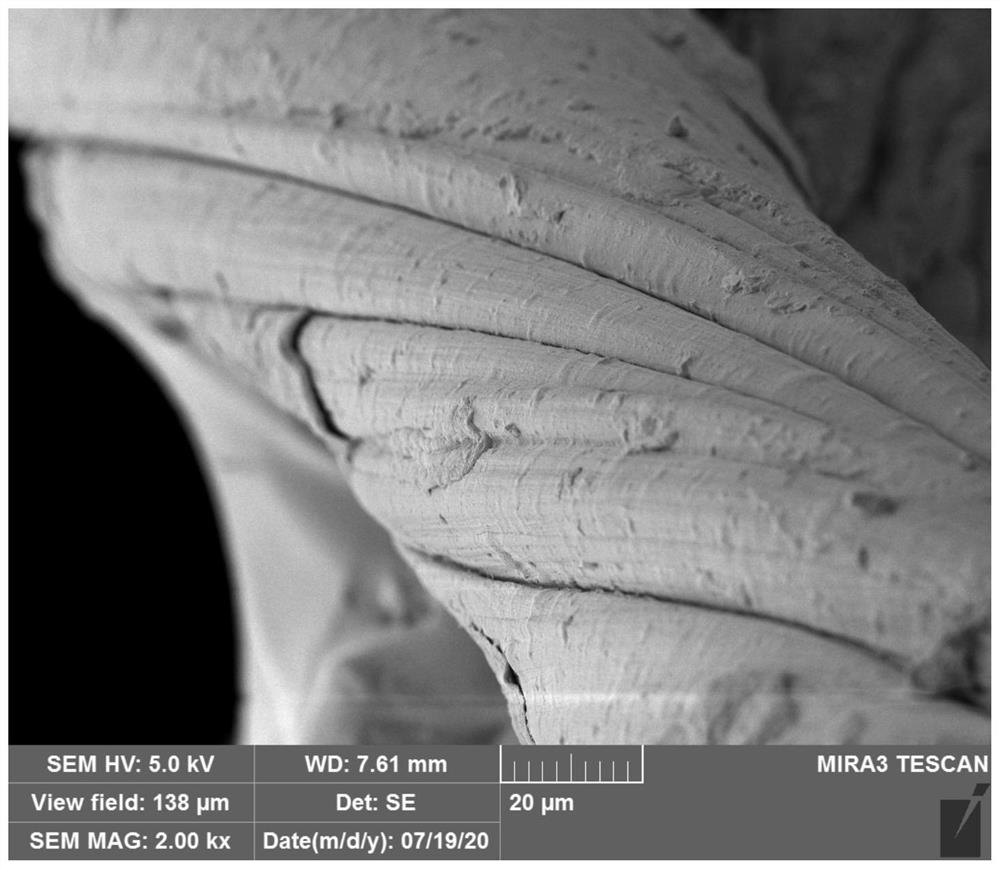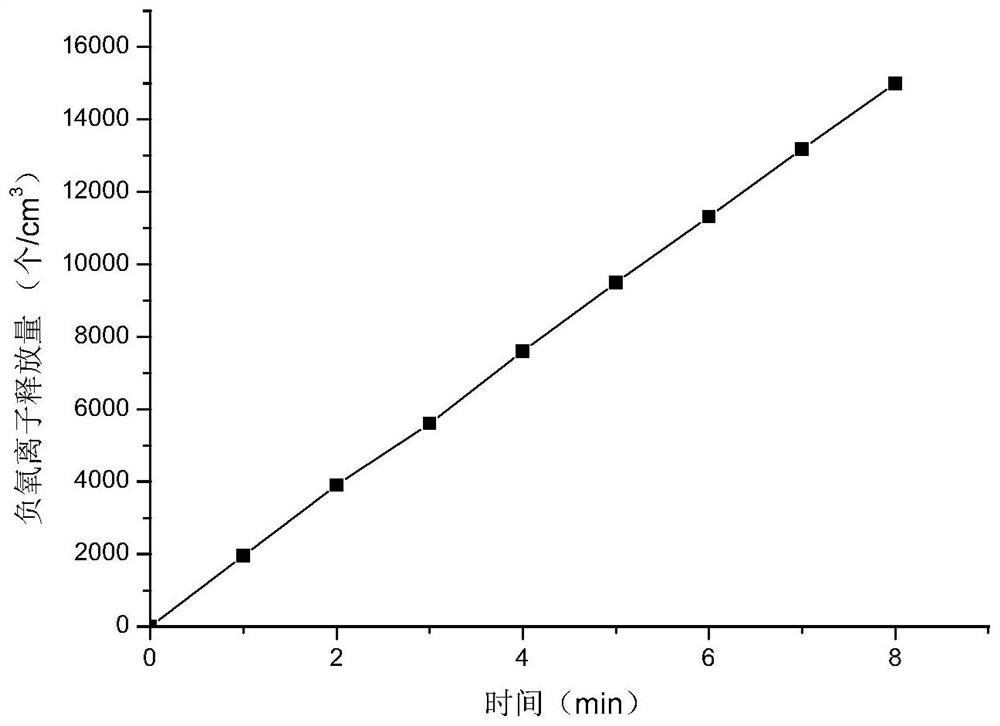Negative oxygen ion biomass-based fiber and preparation method thereof
A technology of negative oxygen ions and biomass, applied in the chemical characteristics of fibers, cellulose/protein conjugated rayon, wet spinning, etc., can solve the problems of poor mechanical properties of negative oxygen ion composite fibers, and achieve excellent negative oxygen Effects of ion release and mechanical properties, good distribution, simple operation
- Summary
- Abstract
- Description
- Claims
- Application Information
AI Technical Summary
Problems solved by technology
Method used
Image
Examples
Embodiment 1
[0034] 1. Soak wood fiber in 2.5M NaOH and 0.4M Na at 80°C 2 SO 3 In the mixed solution of 12h, filtered, and then washed with deionized water to remove lignin and hemicellulose to obtain lignocellulose;
[0035] 2. Add 100 g of completely delignified lignocellulose, 1 g of tourmaline and 100 g of sodium alginate into 5000 mL of deionized water, and transport it to a rubber mill for wet grinding for 12 hours to prepare a cellulose composite suspension;
[0036] 3. Put the suspension into a syringe and squeeze in 0.1mol / L CaCl 2 Single lignocellulose fibers were prepared in the coagulation bath. The extrusion rate (1 mL / min) was controlled by an air pump with a pressure of about 12.5 psi. After the flow rate is stable, collect the uniform gel fibers, soak them in the coagulation bath for about 10 minutes, and then wash the surface Ca with deionized water. 2+ . A single fiber is shown as figure 1 It can be seen from the figure that after wet spinning, the lignocellulosic f...
Embodiment 2
[0039] 1. Soak wood fiber in 10M KOH and 0.01M Na at 60°C 2 SO 3 In the mixed solution of 10h, filter, and then wash with deionized water to remove lignin and hemicellulose to obtain lignocellulose;
[0040] 2. Add 100g of fully delignified lignocellulose, 20g of tourmaline and 200g of sodium alginate into 10,000mL of deionized water, and transport it to a rubber mill for wet grinding for 24h to prepare a cellulose composite suspension;
[0041] 3. Put the suspension into a syringe and squeeze it into a coagulation solution of 0.05mol / L nickel chloride to prepare a single lignocellulose fiber. The extrusion speed (5 mL / min) was controlled by an air pump. After the flow rate is stable, collect the uniform gel fibers, soak them in the coagulation bath for about 30 minutes, and then wash them with deionized water;
[0042] 4. Twist the 3 gel fibers into coarse fibers (18 turns per inch) immediately after stretching, and then stretch and dry at room temperature for 24 hours.
Embodiment 3
[0044] 1. Soak wood fiber in a mixed solution of 5M NaOH and 1M NaClO at 90°C for 15 hours, filter, and then wash with deionized water to remove lignin and hemicellulose to obtain lignocellulose;
[0045] 2. Add 100g of fully delignified lignocellulose, 10g of tourmaline and 150g of sodium alginate into 7500mL of deionized water, and transport it to a rubber mill for wet grinding for 1h to prepare a cellulose composite suspension;
[0046] 3. Put the suspension into a syringe and squeeze it into the coagulation liquid of 1 mol / L ferrous chloride to prepare a single lignocellulose fiber. The extrusion speed (0.1 mL / min) was controlled by an air pump. After the flow rate is stable, collect the uniform gel fibers, soak them in the coagulation bath for about 20 minutes, and then wash them with deionized water;
[0047] 4. Twist the 3 gel fibers into coarse fibers immediately after stretching (1 revolution per inch), and then stretch and dry at room temperature for 24 hours.
PUM
 Login to View More
Login to View More Abstract
Description
Claims
Application Information
 Login to View More
Login to View More - R&D
- Intellectual Property
- Life Sciences
- Materials
- Tech Scout
- Unparalleled Data Quality
- Higher Quality Content
- 60% Fewer Hallucinations
Browse by: Latest US Patents, China's latest patents, Technical Efficacy Thesaurus, Application Domain, Technology Topic, Popular Technical Reports.
© 2025 PatSnap. All rights reserved.Legal|Privacy policy|Modern Slavery Act Transparency Statement|Sitemap|About US| Contact US: help@patsnap.com



